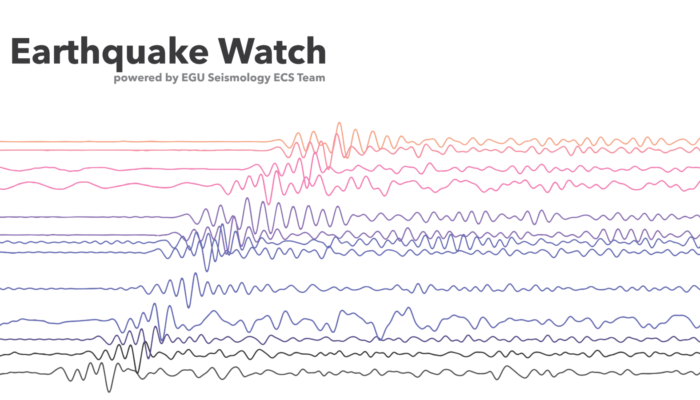
On May 21, a major shallower earthquake (M7.3) hit Central China at 18:04 UTC in the southern Qinghai province (Figure 1). Until this date, this event is the largest onshore earthquake during 2021. The so-called Qinghai earthquake’s hypocenter is located in a remote area near the eastern edge of the Tibetan Plateau, which is formed due to the collision between the India Plate and the Eurasia Plate.

Figure 1 | Location of the Qinghai earthquake and aftershock sequence (USGS catalogue, see colour bar depending on time). The focal mechanism calculated by USGS is plotted for the mainshock. The inverted red triangle indicates the GPS station QHMD.
Faults in this area are east-west trending, and significant shallow earthquakes occur along these faults. For instance, the 2001 M7.8 Kokoxili earthquake ruptured along the Kunlun Fault (Klinger et al., 2005 1). The Qinghai earthquake produces surface shaking and high intensities in a low population region, far from major towns or cities. However, structural damage to the nearest bridge and sand liquefaction was observed (Haibo Yang @tectonics_yang).
According to the focal mechanism estimated, the earthquake shows mainly strike-slip faulting with a small normal faulting component. Preliminary field observation in the area guaranteed a rupture disrupting the ground surface in the vicinity of the fault ruptured. Besides using teleseismic data, seismologists from USGS calculated a source-time function and coseismic slip distribution. These models indicate a bilateral rupture of about 150 km length which broke during 40 seconds, with a maximum slip of ~3 meters (Figure 2).

Figure 2 | Coseismic slip distribution model and source-time function for the M7.3 Qinghai earthquake. Hypocenter denoted by a star. Credits: USGS.
The earthquake was recorded by the near-field GPS station QHMD. This station is located ~40 km north of the epicentre. Figure 3 shows a significant horizontal movement of ~20 cm and ~7 cm in the east-west and north-south components, respectively, but a minor vertical movement without a clear permanent displacement.

Figure 3 | Displacement recorded by the high-rate GNSS station QHMD. Credits: Jianghui Geng @GengJianghui .
The first InSAR (e.g. Figure 4) results show the extension of the rupture, which can be traced along more than 160 km length along the left-lateral Maduo-Gande Fault (Li et al., 2011 2). The main fault trend agrees with the tens of M>4 aftershocks located in the area (Figure 1).

Figure 4 | InSAR results for the Qinghai earthquake. (a) Main fault rupture traced, (b) Sentinel-1 Co-seismic interferogram from LiCSAR COMET track May 20 – May 26, (c) Offset tracking from (b). Credits: Sotiris Valkaniotis @sotisvalkan.
After the rupture, the seismic waves radiated from the hypocenter and were picked up by seismic networks all around the globe. The animation in Figure 5 shows the particle motion across the Alp Array seismograph network. Notable is that the overlap of the direct Rayleigh and Love wave creating an interesting wavefield in the region.
Figure 5 | Ground motion visualization of waves through AlpArray Seismic Network. Credits: ECS representative Angel Ling @okangel92
MAY earthquakes
Southern Qinghai, China – 21st May – M 7.3
Ishinomaki, Japan – 1st May – M 6.8
East Pacific Rise, Juan Fernandez Microplate – 19th May – M 6.7
References
1 Yann Klinger, Xiwei Xu, Paul Tapponnier, Jérome Van der Woerd, Cecile Lasserre, Geoffrey King; High-Resolution Satellite Imagery Mapping of the Surface Rupture and Slip Distribution of the Mw ∼7.8, 14 November 2001 Kokoxili Earthquake, Kunlun Fault, Northern Tibet, China. Bulletin of the Seismological Society of America 2005; 95 (5): 1970–1987. doi:https://doi.org/10.1785/0120040233
2 Li, C., Xu, X., Wen, X., Zheng, R., Chen, G., Yang, H., … & Gao, X. (2011). Rupture segmentation and slip partitioning of the mid-eastern part of the Kunlun Fault, north Tibetan Plateau. Science China Earth Sciences, 54(11), 1730.
Note: This blog corresponds to a brief seismological review of the preliminary results about a mainshock event and seismic activity. An earthquake can be disastrous for neighbouring towns and people. When our team picks an “Earthquake of the month” (now “Earthquake Watch”) it is important to keep in mind that we are not looking for the most mediatic and deadly one. We are generally looking for regions where we can learn more about the seismic hazard, seismotectonic background, and social impact, which we put together with preliminary contributions. Understanding the seismic hazard is one way to address disaster risk reduction and develop resilient cities. As EGU Seismology ECS Team, our thoughts are with the earthquake struck communities in this challenging time.
This blog post was written by ECS representative Javier Ojeda
with revisions from ECS representative Maria Tsekhmistrenko
